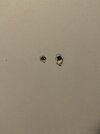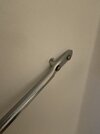Let's talk a bit about how the walls in your home are constructed. They aren't shocking; they're the reason (unless the builders made an ass job of it) that your heating bill isn't as sky high as your mate in his solid walled, mouldy Victorian house
The wall is made of vertical wooden struts (studs), probably 4x2 or just slightly less that are clad on one side with a wood panel and clad on the other side with plasterboard. The studs are probably 400 or 600mm apart and may appear in multiples side by side around areas that need extra strength because they are carrying something vital to the structure, like a steel beam
Plasterboard is a sandwich of gypsum between two sheets of paper, and is probably 12.5 mm thick. It's a cost effective, smooth wall surface but it is not, by any stretch of the imagination, strong or able to resist being crushed.
You generally need to use special fixings to attach anything more supportive than a picture hook to plasterboard and you cannot use wall plugs (tubes of plastic that expabd when a screw is driven into them) because the plaster is just crushed and turns into powder.
You especially cannot use the screws and wall plugs that come with most curtain rails because they're utter garbage and should be binned.
I'd go as far to say you shouldn't mount a curtain pole in plasterboard at all, especially if it's a heavy curtain. If you have a light weight curtain you could look at fixings called "hollow wall anchors"
You drill a large hole and push it though. You then should really use a setting tool, which looks like a gun, that pulls on the screw, deforming the plug and splaying the legs out. The legs bend until they contact the back of the plasterboard, gripping it front and back and spreading any load out over a larger area. Once splayed the screw can be removed completely and reinserted to fix a bracket etc. If you don't have a setting tool you can wind the screw to splay the plug but it's easy to over-splay them, so go easy. Same applies for when screwing the screw in to fix the bracket; don't overtighten
-
If you're not mounting to the plasterboard, you should look to fix through the he plasterboard and into the studs in the wall. There isn't a guarantee that they are well placed, though in a timber frame they should run up the sides of the windows. You can find them by rubbing a magnet over the wall; the plasterboard is screwed to the studs so picking up plasterboard screws in the wall using a strong magnet
If you find that the studs aren't where you want them to be, consider screwing a piece of wood to the wall, driving screws into the studs, and then fix the curtain hangers to the wood





